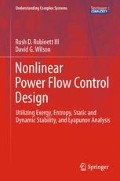Abstract
The swing equations for renewable generators connected to the grid and islanded configuration are developed. A wind turbine is used as an example. The swing equations for the renewable generators are formulated as a natural Hamiltonian system with externally applied nonconservative forces. HSSPFC is used to analyze and design feedback controllers for the renewable generators system. This formulation extends previous results on the analytical verification of the Potential Energy Boundary Surface (PEBS) method to nonlinear control analysis and design and justifies the decomposition of the system into conservative and nonconservative systems to enable a two-step, serial analysis and design procedure. The first step is to analyze the system as a conservative natural Hamiltonian system with no externally applied nonconservative forces. The Hamiltonian surface of the swing equations is related to the Equal-Area Criterion and the PEBS method to formulate the nonlinear transient stability problem. This formulation demonstrates the effectiveness of proportional feedback control to expand the stability region. The second step is to analyze the system as a natural Hamiltonian system with externally applied nonconservative forces. The time derivative of the Hamiltonian produces the work/rate (power flow) equations that are used to ensure balanced power flows from the renewable generators to the loads. The Second Law of Thermodynamics is applied to the power flow equations to determine the stability boundaries (limit cycles) of the renewable generators system and enable design of feedback controllers that meet stability requirements while maximizing the power generation and flow to the load. Necessary and sufficient conditions for stability of renewable generators systems are determined based on the concepts of Hamiltonian systems, power flow, exergy (the maximum work that can be extracted from an energy flow) rate, and entropy rate.
Access this chapter
Tax calculation will be finalised at checkout
Purchases are for personal use only
References
Junkins, J.L., Kim, Y.: Introduction to Dynamics and Control of Flexible Structures. AIAA, Washington (1993)
Robinett III, R.D., Wilson, D.G.: Transient stability and control of renewable generators based on Hamiltonian surface shaping and power flow control: Part I—Theory. In: IEEE MSC Conference, Yokohama, Japan, September 2010
Slotine, J.-J.E., Li, W.: Applied Nonlinear Control. Prentice Hall, Englewood Cliffs (1991)
http://www.sandia.gov/SAI/files/SEGIS%20Concept%20Paper-071025.pdf
Vittal, V., Michel, A.N., Fouad, A.A.: Power system transient stability analysis: formulation as nearly Hamiltonian systems. Journal of Circuits, Systems, and Signal Processing 3(1) (1984)
Alberto, L.F.C., Bretas, N.G.: Application of Melnikov’s method for computing heteroclinic orbits in a classical SMIB power system model. IEEE Trans. Circuits Syst. I, Fundam. Theory Appl. 47(7), 1085–1089 (2000)
Ghandhari, M.: Control Lyapunov functions: a control strategy for damping of power oscillations in large power systems. Doctoral Dissertation, TRITA-EES-0004, ISSN 1100-1607, Royal Institute of Technology, Stockholm, Sweden (2000)
Gross, C.A.: Power System Analysis. Wiley, New York (1986)
Wilson, D.G., Robinett III, R.D.: Nonlinear power flow control applications to conventional generator swing equations subject to variable generation. In: International Symposium on Power Electronics, Electrical Drives, Automation and Motion, SPEEDAM 2010, Pisa, Italy, June 14–16, 2010
Pai, M.A.: Power System Stability—Analysis by the Direct Method of Lyapunov. North-Holland, Amsterdam (1981)
Sauer, P.W., Pai, M.A.: Power System Dynamics and Stability. Stipes Publishing Co. (1997)
Wilson, D.G., Robinett III, R.D.: Transient stability and control of wind turbine generation based on Hamiltonian surface shaping and power flow control. In: 9th International Workshop on Large-Scale Integration of Wind Power into Power Systems as Well as on Transmission Networks for Offshore Wind Power Plants, Quebec City, Quebec, Canada, October 2010
Author information
Authors and Affiliations
Corresponding author
Rights and permissions
Copyright information
© 2011 Springer-Verlag London Limited
About this chapter
Cite this chapter
Robinett, R.D., Wilson, D.G. (2011). Case Study #5: Renewable Energy Microgrid Design. In: Nonlinear Power Flow Control Design. Understanding Complex Systems. Springer, London. https://doi.org/10.1007/978-0-85729-823-2_10
Download citation
DOI: https://doi.org/10.1007/978-0-85729-823-2_10
Publisher Name: Springer, London
Print ISBN: 978-0-85729-822-5
Online ISBN: 978-0-85729-823-2
eBook Packages: Physics and AstronomyPhysics and Astronomy (R0)

